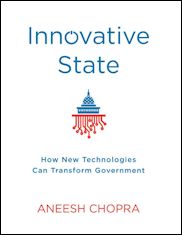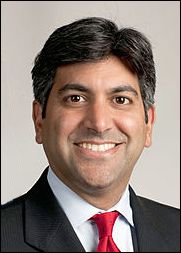
Innovative State, 2014, by Aneesh Chopra; used with permission of the publisher, Grove/Atlantic, Inc.
In his new book, “Innovative State: How New Technologies Can Transform Government,” Aneesh Chopra makes the case for using technology to transform government in the United States. Weary of the old liberal-conservative debate of more government/less government, Chopra espouses effective government. In this book, he comes across as conservative in his frank acknowledgment that government often falls short in the execution of its goals. But the former Virginia Secretary of Technology and former Chief Technology Office for the Obama administration remains steadfastly liberal in his conviction that government can be a force for good.
While I hew to the view that less is more when it comes to government, I concede that certain core functions in American society are best provided by government. I believe that what government chooses to do, it should do well. And, like Chopra, I believe that technology can play a major role in improving government performance. That’s why I’m excited to make available to readers of Bacon’s Rebellion Chapter 3 of his book, which describes his experience as Secretary of Technology during the Kaine administration. I expect that readers will be impressed by Chopra’s approach as a pragmatic problem solver and encouraged how often, away from the spotlight, Virginia politicians are willing to cooperate on a non-partisan basis to get things done.
After resigning his job as CTO for the federal government (you’ll have to buy the book to find out what he did in that post), Chopra made an unsuccessful bid for the Democratic Party nomination as Lieutenant Governor. But he remains active in Virginia, as co-founder of Hunch Analytics, based in Rosslyn, which applies Big Data and Predictive Analytics to solve problems in education, energy and health care, and working behind the scenes with Governor Terry McAuliffe on workforce development and veterans affairs. I expect we’ll be hearing more from Chopra who, at 42, has a long career ahead of him. — JAB
Chapter 3
The Virginia Model
Back in 1999, the Virginia legislature was seeking to make someone accountable for nurturing entirely new industries throughout the state, while making sure the government’s internal use of information technology was effective and efficient. Virginia became the first state in the nation to create a cabinet position for a Secretary of Technology. Three men would fill that role over the next six years, and their work over that time contributed to Governing magazine’s 2005 selection of Virginia as the “Best Managed State.”
In 2006, Tim Kaine, the successor to outgoing Governor Mark Warner, chose me to the the fourth Secretary of Technology. He had a different spin on the position, one in tune with the times. By 2006, the Internet had transformed the way consumers accessed information and conducted commerce. yet, though it had improved some services such as e-filing tax returns and renewing professional licenses, it had not meaningfully transformed the relationship between citizens and their government. Kaine assigned me to prioritize the improvement of that interface. I realized that one of the most important things government can do is remove restrictions that exist for really no good reason. On a visit to Google, for example, I learned two things: one, most people get to government websites through search engines, not by typing in their URLs, or bookmarking them; and second, government, perhaps unintentionally, made it difficult for search engines to index information that the public had the right to know. Within 90 days, we initiated a no-cost collaboration to simplify and standardize the interface between search engines and government websites, making it easier for the public to find what they need. We formed a coalition of four states, two led by Republican governors (Utah, California) and two by Democratic ones (Arizona, Virginia), whereby Google, Yahoo and Ask.com agreed on a standard sitemap protocol that the states agreed to adopt. Those states then assigned their webmasters to implement the new protocol, a task that took about an hour per site. By the launch in April 2007, Virginia had tagged about 80,000 of our own web pages (URLs) for addition to the participating search engines. In the first year of the initiatives, we observed a 40 percent spike in site visitors, at no cost other than the modest incremental staff effort.
One of the promising aspects of that initiative was its bipartisan backing. Before my term even started, and as it progressed, I made a point to reach out to members of the Republican-led legislature. Through those conversations, I became convinced that many in both parties viewed technology, data, and innovation initiatives from a more pragmatic prism, beyond the usual, inflexible left-right division. That was evident when those Republicans invited me, a Democrat, to partner as a nonvoting participant on the Joint Committee of Technology and Science (JCOTS), which organized small working groups that included members of the executive and legislative branches, as well as concerned citizens. More than a dozen bills endorsed by JCOTS passed through the legislature with overwhelming bipartisan support and were signed into law by Governor Kaine, including Republican-sponsored legislation to expand rural broadband access, adopt health IT standards, and permit school boards to purchase open source education resources.
Democrats, while a minority in the legislature, also attempted to put their signature on the smarter government movement, with the endorsement of the executive branch. Consider the way Business One Stop came together. Governor Kaine, wanting to buoy the state’s reputation as business friendly, sought to offer every Virginia entrepreneur a single destination to complete all the forms required to start a new enterprise — a task that otherwise might involved as many as seven state agencies, such as the State Corporation Commission, the Virginia Department of Taxation, and the Virginia Employment Commission. Governor Kaine, inspired by South Carolina’s presentation at a National Governors Association meeting, gave me the assignment of creating something similar.
Upon digging in, our team estimated that implementing the South Carolina model — which not only improved the user experience but also connected with existing systems within each impacted agency — would require an investment of roughly $7 million. That estimate far exceeded our available funds. So I improvised… Continue reading.



